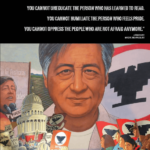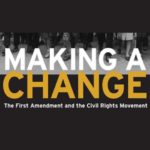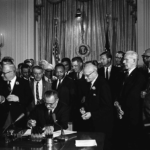When most people think of the Civil Rights Movement in America, they think of Martin Luther King, Jr. delivering his “I Have a Dream” speech on the steps of the Lincoln Memorial in 1963 and receiving the Nobel Peace Prize the following year. But “the Movement” achieved its greatest results — the 1964 Civil Rights Act and the 1965 Voting Rights Act — due to the competing strategies and agendas of diverse individuals. Even black Americans, the primary beneficiaries of this landmark legislation, did not agree on the tactics that should be used to secure the equal protection of their rights. This unit presents the views of several important black leaders who shaped the debate over how to achieve freedom and equality in a nation that had long denied a portion of the American citizenry the full protection of their rights.
Civil Rights
While the Reconstruction Amendments were an important step in ensuring equal rights for all people, regardless of race, racial injustices throughout the United States continued into the late 19th and 20th centuries, leading to the Civil Rights movement of the 1960s, and the passages of Supreme Court decisions and legislation, including Brown v. Board of Education, the Civil Rights Act of 1964, and the Voting Rights Act of 1965. Visit the National Constitution Center’s learning module to learn more about the freedom struggle and civil rights.
Freedom Summer 1964
Freedom Summer is a digital learning tool (available on the web or as an app) for teachers and students that explores key events surrounding this time in America’s history and the impact of the civil rights movement on civil rights legislation. Players predict the outcomes of civil and congressional actions and discover how the events are intertwined. Students have the opportunity to view informative intro and outro videos and analyze 20 primary sources depicting images of civil rights events. Analysis of a variety of primary sources and supplemental information leads students to identify varying perspectives and potential outcomes. Freedom Summer is formatted for all types of computers and mobile devices, including Chromebooks, and can be found on the website or in any app store for download.
African American Religious Leadership and the Civil Rights Movement
The modern Civil Rights Movement was the most important social protest movement of the twentieth century. People who were locked out of the formal political process due to racial barriers were able to mount numerous campaigns over three decades to eradicate racial injustice and in the process transform the nation. In its greatest accomplishment, the Civil Rights Movement successfully eliminated the American apartheid system popularly known as Jim Crow. Registration is required to view this resource. Free registration for students and teachers required to access resource.
Black History Month Lesson Plans on Nonviolence
The power of nonviolent actions and attitudes as a means to resist oppression and spur reforms is a recurring feature of democratic and democratizing societies. The School Violence Prevention Demonstration Program presents educators with lesson plans that explore the use of nonviolence in history, paying particular attention to the civil rights movement and African American history. Six lessons address: the 1963 Children’s March; the concept of nonviolence using primary sources and stories of participants in the civil rights movement; the power of nonviolence; the story of Rosa Parks; citizenship schools; how music can be used to achieve social and political change.
Rights of Farm Workers: Labor Leaders César Chávez and Dolores Huerta

March 31 is César Chávez Day and April 10 is Dolores Huerta Day. Use these K-12 lesson plans and resources to celebrate the life and legacy of these civil rights and labor activists. Topics span their co-founding of the United Farm Workers union, their use of nonviolent protests to fight for the rights of laborers and includes other change-makers like Lucas Benitez and Librada Paz.
Making a Change: The First Amendment and the Civil Rights Movement

Delve into hundreds of historical newspapers, videos, photographs and more to find out how the five freedoms empowered people fighting for change — and those fighting against it. Topics include: the history of the American civil rights movement, the relationship between the movement and the news media, the evolution and application of First Amendment freedoms, bias in the news, civic engagement and more.
1968: The Poor People’s Campaign
1968 was a tumultuous period in the United States. The Vietnam War, political assassinations and civil rights issues were among some of the challenges the country faced as solutions were sought. At this time, Martin Luther King Jr. organized the Poor People’s Campaign to shift the focus of the civil rights movement to economic issues; however, Reverend King was assassinated weeks before the campaign got underway in Washington, D.C. In this lesson, students will learn about the circumstances that gave rise to this campaign and how it is relevant today.
The 1964 Civil Rights Act: Lesson Plans and Resources

On July 2, 1964, President Lyndon B. Johnson signed the Civil Rights Act into law. Originally proposed by President Kennedy in 1963, this landmark piece of legislation made discrimination based on race, religion, sex or national origin illegal. Additionally, the Civil Rights Act ended the practice of unequal voter requirements based on race or sex and ended racial segregation in schools. The Share My Lesson team has curated a collection of free lesson plans, activities, and classroom materials for educators to use in teaching students about the Civil Rights Act.
